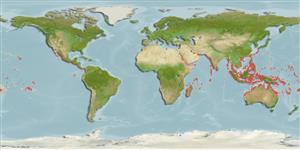Teleostei (teleosts) >
Gobiiformes (Gobies) >
Gobiidae (Gobies) > Gobiinae
Etymology: Bathygobius: Greek, bathys = deep + Latin, gobius = gudgeon (Ref. 45335).
More on author: Rüppell.
Environment: milieu / climate zone / depth range / distribution range
Ecology
Marine; freshwater; brackish; reef-associated; amphidromous (Ref. 51243); depth range 0 - 6 m (Ref. 86942). Tropical; 30°N - 30°S
Indo-Pacific: Red Sea south to Bazaruto, Mozambique (Ref. 2798) and east to the Line and Tuamoto islands, north to South Korea and southern Japan, south to the southern Great Barrier Reef. Does not occur in the Hawaiian Islands (Ref. 7490).
Size / Weight / Age
Maturity: Lm ? range ? - ? cm
Max length : 12.0 cm TL male/unsexed; (Ref. 4343)
Dorsal spines (total): 7; Dorsal soft rays (total): 9; Anal spines: 1; Anal soft rays: 8. Characterized further by pale yellowish brown color with large, irregular dark brown blotches on body; small, pale blue spots (one per scale) in longitudinal rows on body; dorsal and caudal fins with small blue spots, outer edge of dorsal fins broadly yellow; upper three pectoral rays partly free of membrane; rounded caudal fin; longitudinal scale series 29-36; predorsal scales 10-19, reaching from above middle of preopercle nearly to interorbital space; cheek and opercle without scales; ctenoid body scales, becoming cycloid on abdomen, breast and nape; depressed head, width greater than depth; depth of body 4.4-5.0 in SL (Ref. 90102).
Inhabits shallow rocky areas, often in pools of the intertidal zone (Ref. 2798). Occurs mostly in coastal areas. Also found in estuaries, tidal zones and often ascending into freshwater streams; smaller species live between branches of corals where they exploit several crustacean groups. Feeds on crustaceans, fish and algae (Ref. 92840). Sometimes seen as fresh catches at markets (Ref. 12693).
Life cycle and mating behavior
Maturity | Reproduction | Spawning | Eggs | Fecundity | Larvae
Benthic spawner. Also Ref. 32023.
Hoese, D.F., 1986. Gobiidae. p. 774-807. In M.M. Smith and P.C. Heemstra (eds.) Smiths' sea fishes. Springer-Verlag, Berlin. (Ref. 2798)
IUCN Red List Status (Ref. 130435: Version 2024-2)
Threat to humans
Harmless
Human uses
Fisheries: minor commercial
Tools
Special reports
Download XML
Internet sources
Estimates based on models
Preferred temperature (Ref.
123201): 24.9 - 29.3, mean 28.4 °C (based on 3467 cells).
Phylogenetic diversity index (Ref.
82804): PD
50 = 0.5000 [Uniqueness, from 0.5 = low to 2.0 = high].
Bayesian length-weight: a=0.01023 (0.00477 - 0.02194), b=3.01 (2.83 - 3.19), in cm total length, based on LWR estimates for this (Sub)family-body shape (Ref.
93245).
Trophic level (Ref.
69278): 3.4 ±0.6 se; based on diet studies.
Resilience (Ref.
120179): High, minimum population doubling time less than 15 months (Preliminary K or Fecundity.).
Fishing Vulnerability (Ref.
59153): Low vulnerability (10 of 100).
Nutrients (Ref.
124155): Calcium = 114 [61, 258] mg/100g; Iron = 0.861 [0.426, 1.636] mg/100g; Protein = 18.7 [16.7, 20.4] %; Omega3 = 0.134 [0.057, 0.266] g/100g; Selenium = 15.1 [7.5, 32.3] μg/100g; VitaminA = 195 [53, 659] μg/100g; Zinc = 2.01 [1.31, 3.06] mg/100g (wet weight);
